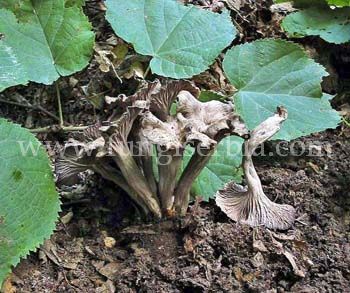Cantharellus cinereus (Pers.) Fr.

Fruit body: irregular shape like trumpet, up to 8 cm high and 5 cm wide, dark grey. Hymenial surface is somewhat brighter, consists of very branched network of vein-like protuberances. Stem is relatively long, fibrous, greyish.
Microscopy: Spores are ellipsoid to ovoid, smooth, hyaline, 7-12x5-9 μm. Basidia are mainly with 4 spores, but there are with 5 or 6 sterigma.
Flesh: Greyish, very pleasant smell reminiscent of boiled plums.
Habitat: season summer and autumn, in dense clusters, in deciduous woods.
Edibility: Edible, excellent.
Commnet: This species is most often found together with Black Trumpet (Craterellus cornucopioides), from which it can be easily differentiated by hymenophore. Black Trumpet has lightly wrinkled hymenophore, while in C. cinereus it looks like gills.
Reference: Uzelac, B. (2009). Gljive Srbije i zapadnog Balkana, BGV Logik,